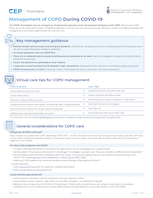The following condition-specific resources were developed in the context of the COVID-19 pandemic, when necessity required deviation from existing evidence-based guidelines as in-person visits were significantly limited. Certain frameworks and guidance within the resources are applicable only to the “crisis care” needs during the COVID-19 pandemic and should be reviewed with this consideration in mind. Established Clinical Practice Guidelines are the authoritative source for evidence-based care for each condition.
Management of COPD during COVID-19

The COVID-19 pandemic has not changed our fundamental approach to the management of patients with COPD. Most routine COPD follow-up can be conducted virtually. Thoughtful integration of virtual care can improve encounter efficiency, enable more effective patient self- management and increase opportunities for proactive care.
Key management guidance
- Patients should continue to get care during the pandemic. At minimum, see patients in person annually and perform bloodwork twice per year to avoid missing any change in symptoms.
- Increased symptoms: Rule out COVID first.
- There are no validated tools to assess breathlessness by telephone or by video. Use clinical judgement supported by careful history-taking and questioning.
- Ensure that patients are optimized on their inhalers.
- Lung cancer screening should not be delayed in high-risk patients. See guidelines for lung cancer screening (Canadian Task Force).
- COVID-19 vaccination is critical. Proactively contact COPD patients to discuss vaccination and answer questions.
Virtual care tips for COPD management
- Comprehensive physical exam: Supplement phone visit with video call
- Clarify instructions: Follow up phone call with an email
- Shorten or reduce follow up visits: Email resources or plans in advance or afterwards
- Simple questions about medications, monitoring, tests or appointments: Use email and secure messaging
- Clinical concerns where non-verbal cues are important: Use video call
- Collaboration with specialists/other providers: Email/video/provider-to-provider calls
For more tips, see the Enhancing Management of Chronic Conditions Using Virtual Care During COVID-19 toolkit (CEP)
Click on the sections below to get started:
General considerations for COPD care New
Is diagnosis of COPD confirmed?
If you suspect your patient has COPD, determine if FEV1/FVC = <0.70 or the lower limit of normal. The use of spirometry and other PFTs may not be widely available during the pandemic. If home spirometry is not an option, set a reminder for future spirometry to ensure that a diagnosis is not missed.
Are day-to-day symptoms controlled?
- Consider collecting information on symptoms through email or secure messaging prior to appointment
- Ask the patient: “How have you felt recently? A month ago?” If a caregiver is present, ask: “Have you noticed any differences [in the patient]?”
- Ask the patient to describe their breathing in their own words. “Are you so breathless that you are unable to speak more than a few words?” See: Assessing dyspnoea by telephone or video (Oxford CEBM, 2020)
- Build trust. COPD patients may minimize symptoms due to feelings of fear, guilt and shame (Russell 2018, Clari 2017)
Provider resources:
- COPD Assessment Test (CAT) for patient to complete beforehand
- COPD remote follow-up checklist (GOLD)
Is pharmacotherapy optimized?
- Assess patient’s compliance with all medications (not just respiratory meds)
- If exacerbation-prone, consider LABA/LAMA/ICS plus PDE 4 inhibitor or antibiotics as needed (Cochrane 2020, GOLD 2020)
- Nebulizers may increase the risk of COVID-19 transmission. Patients who live with others can consider switching to an alternative treatment form, such as metered-dose inhaler (MDI) therapy with spacing device, dry powder inhaler or soft mist inhaler
Uncontrolled symptoms during COVID-19 New
- Determine if worsening disease control is related to comorbid conditions
- If on video, look for concerning physical signs such as audible wheeze or blue lips
- Assume COVID. Advise patients experiencing symptoms to be tested for COVID as soon as possible
Negative COVID test result
- Determine if disease control can be re-established in an outpatient setting
- Outpatient tests may include measurement of arterial blood gas, CXR, routine blood tests or other tests as deemed necessary
- Consider in-person management if uncertain about the etiology of worsening disease control
Provider resources:
Positive COVID test results
- Ask: “Can this patient be managed outside of hospital? What is my follow-up plan to ensure control stability?”
- Determine if control trajectory is downward or significantly below baseline levels
- If patient has oximeter, assess SaO2 and compare to baseline. If SaO2 ≤90% on room air, refer to emergency care. Primary careproviders can supply their patients with
oximeters using COVID@Home Monitoring
for Primary Care (OCFP, 2020).
Tips for COVID-positive COPD patients managing their illness at home (CCJM 2020):
- If a nebulizer is used, use in a room with doors closed and keep them closed for several hours afterwards. Open windows if possible
- Consider increasing the frequency of bronchodilator use
- Access local oxygen and respiratory services (CEP)
COVID-19 has not been shown to cause exacerbations. If a patient has an exacerbation concurrent with COVID-19 (CCJM 2020):
- Standard-of-care treatment with corticosteroids is recommended
- Glycemic control may be an additional challenge when using corticosteroids in this population
Optimizing patient self-management New
Self-management directly impacts autonomy, self-efficacy, motivation to change, pain-free days and functional capacity (Rochfort 2018).
Virtual care can improve self-management by removing barriers of attending frequent in-person visits, providing patients with tools to learn, self-monitor, and get feedback from their providers synchronously or asynchronously.
COVID prevention
- Discuss receiving COVID vaccine as soon as possible
- Reinforce importance of physical distancing, wearing a mask, hand washing and staying within a social bubble
Provider resources
- Vaccine emerging evidence (CEP): Up-to-date information on vaccine safety, effectiveness and other key topics
Patient resources
Education
- Improving patient knowledge of COPD has been shown to reduce hospitalizations and emergency service use (Clari, 2017). Ensure patient understands what their diagnosis means, how treatment can help and their role in managing symptoms
Support groups
Support groups increase patient motivation, knowledge, problem-solving capacity and reduce distress associated with COPD symptoms (Russell, Clari, Clari, Robinson).
- Online support groups provide a safe and easy way for patients to join
- Caregivers need support too. Share resources to connect them with other caregivers as well as to maintain wellness and reduce burnout
Action plan
Action plans enable some patients to promptly respond to worsening symptoms and can reduce visits to the hospital. Plans can be developed with patients virtually or in person, and pre-pandemic action plans can be used with modifications.
Review and update:
- How to recognize early loss of disease control/importance of COVID testing when uncontrolled
- Caregiver and clinic contact information if these have changed during pandemic
- Antibiotic/prednisone access. Ensure patient has a prescription to avoid delays in treatment
- Contact information for prompt virtual or in-person-based care
Exercise
Physical exercise has been shown to reduce ER visits and hospitalizations (Newham 2017). Review online options for physical exercise during the pandemic (linked at right)
Smoking cessation
Added stress of the pandemic may make the idea to quit smoking more difficult for some, while restrictions on social gatherings may make it easier to quit for others.
- Build trust through non-judgmental conversation
- Include advocate/caregiver in this conversation to help patient feel supported
Provider resources
Patient resources
- CAMH STOP free online program.
- Toll-free Quitline: 1-866-366- 3667
- SmokersHelpline.ca: Facts, support groups, forums.
Mental health
Mental health directly affects patient motivation for self-management. Screen for changes to the patient’s mental health by emailing instruments for the patient to complete and return before their appointment.
Pulmonary rehabilitation
Pulmonary rehabilitation should be encouraged to improve function and prevent future exacerbations. Some centres may offer in-person pulmonary rehabilitation during the pandemic (linked at right). There is also evidence of efficacy of virtual-based programs (CTS).
Remote monitoring
Remote monitoring allows for the ongoing assessment of patient health, providing data to guide care planning, identifying education needs, addressing emerging health concerns and proactive interventions.
- Remote monitoring can be beneficial to more complex patients to reduce admissions
- Telehomecare for COPD (OTN) provides a RM kit and involves regular touchpoints by a nurse to monitor symptoms and promote self-management
Acknowledgment and legal
This Resource was developed by the Centre for Effective Practice and Department of Family and Community Medicine, University of Toronto. Clinical leadership for the development of the Resource was provided by Dr. Anthony D’Urzo and by the Management of COPD During COVID-19 Working Group. The Managing Chronic Conditions during COVID-19 Advisory Committee provided feedback and input. This Resource was also subject to external review by health care providers and other relevant stakeholders. The development of this Resource was funded by the Government of Ontario as part of the Knowledge Translation in Primary Care.
Clinical Lead
• Anthony D’Urzo MD, MSc
Working Group
• Payal Agarwal MD, CCFP, BASC
• Barbara Moore (Patient Representative)
• Jennifer Young MD, FCFP-EM
Advisory Committee
• Noah Ivers, MD, PhD, CCFP
• Tara Kiran, MD, MSc, CCFP, FCFP
• Daniel Pepe, MD, CCFP
• Sarah Newbery MD, CCFP, FCFP, FRRMS
• Nicole Nitti, MD, CCFP(EM), FCFP
• Anna Holland MD, CCFP (AM)
• Mia Biondi PhD, NP-PHC
• Jennifer Young, MD, FCFP-EM (Ontario College of Family Physicians)
• Kevin Samson MD (Association of Family Health Teams of Ontario)
• Danika Voisin (eHealth Centre of Excellence)
• Laurie Poole RN, MHSA (Ontario Health, OTN)
• Reza Talebi MD, MSc (OntarioMD)
• Maurine Parzen RN, PhD (Patient Representative)
Thank you to everyone who supported the development of this resource.
Conflict of interest
• Clinical Leads receive compensation for their role
• Clinical Working Group receive an honorarium for their participation
• Focus group and usability participants receive a small token of appreciation (e.g. gift certificate)
This Resource was developed for licensed health care professionals in Canada as a guide only and does not constitute medical or other professional advice. Primary care providers and other health care professionals are required to exercise their own clinical judgment in using this Resource.
Management of COPD During COVID-19 is a product of the Centre for Effective Practice and Department of Family and Community Medicine, University of Toronto. Permission to use, copy, and distribute this material for all non-commercial and research purposes is granted, provided the above disclaimer, this paragraph and the following paragraphs, and appropriate citations appear in all copies, modifications, and distributions. Use of Management of COPD During COVID-19 for commercial purposes or any modifications of the Resource are subject to charge and use must be negotiated with the Centre for Effective Practice (Email: info@cep.health).
Developed by

With support from








